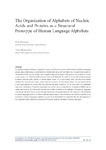The organiation of alphabets of nucleic acids and proteins as a structural prototype of human language alphabets

View/
Use this link to cite
http://hdl.handle.net/2183/13375Collections
Metadata
Show full item recordTitle
The organiation of alphabets of nucleic acids and proteins as a structural prototype of human language alphabetsDate
2012Citation
Culture of communication / Communication of culture, 2012: 739-750. ISBN: 978-84-9749-522-6
Abstract
[Abstract] An alphabet analysis of English, Spanish, Russian, and Vietnamese texts, which belong to different language groups, shows that among vowels there is a predominant group of four letters that is equal to the number of nucleotides of NA (nucleic acids) in the biological language alphabets. The quantity of consonants in these texts is equal to (in English and Russian) or near to (in Spanish) 20, which is the number of triplet groups of mRNA and the same number of protein amino acids. As is well known, DNA and RNA nucleotides combine the functions of energy carrier with the functions of information carrier. It was ascertained by a functional analysis of vowels that they perform the same functions. At the same time the consonants carry only information. Therefore consonants are similar not to nucleotides but to triplets of mRNA and to protein amino acid. We believe that the optimal number of letters in the alphabet of biogenetic languages was brought about by bio-evolution through the process of natural selection. The analysis of the alphabets of human languages leads us to believe that this achievement of bio-evolution was realized naturally in the evolution of human languages alphabets as well. It could therefore be concluded that the development of this approach could enlarge the spectrum of linguistic analysis methods of human languages.
ISBN
978-84-9749-522-6





